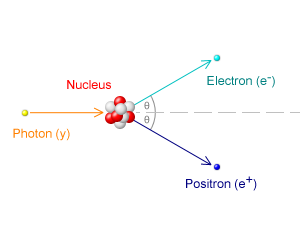lpetrich wrote:It doesn't have to ever be at rest. The relativistic energy-momentum relation is
E2 = p2 + m2
using c = 1, energy E, momentum p, and rest mass m. For a photon, E = |p|, meaning that m = 0. Farsight, you'll make professional physicists LOL.
LOL, lpetrich, you're being evasive and simplistic. Before pair production the mass term is zero, after pair production when you're comoving with the electron, the momentum term is zero. After annihilation the mass term is zero again. It's a flip-flop that gives an experimental demonstration of the symmetry between momentum and inertia.
lpetrich wrote:But what's so special about it? From the looks of it, it doesn't look like Einstein disagrees with other physicists about its interpretation.
What's special about it is that you can apply it to the photon and the electron in pair production and annihilation, and understand mass. The difference between momentum and inertia depends only on motion. A self-trapped photon has mass instead of momentum because it isn't going anywhere.
lpetrich wrote:Farsight, you need a course in Feynman Rules 101. The following are all equivalent on a particle level:
e + gam -> e
e -> e + gam
e* + gam -> e*
e* -> e* + gam
gam -> e + e*
e + e* -> gam
Compton, inverse Compton, positron Compton, positron Inverse Compton, pair production, and annihilation, where we usually see gam gam. Simple stuff. Sounds to me as if you're using mathematics as a shield to avoid understanding the electron.
lpetrich wrote:One similarly finds that pair production and pair annihilation are particle-level equivalents of Compton scattering.
You're fooling yourself, and you are the easiest person to fool. They simply aren't the same, and in no way are they equivalent. Pair production
creates your "spinorness". It
creates the electron. It
creates mass and charge, because the photon is no longer moving laterally at c. Instead it's going
round at c. That's why the electron has its angular momentum and magnetic dipole moment. Chuck another photon at it and it acquires action and an additional velocity vector so the component photon then moves in a helical path. Keep on adding to it and you're straightening out the path more and more. Indeed, that means Compton scattering is the opposite of pair production.
lpetrich wrote:Farsight, that is just plain irrelevant.
No, it isn't. It gets to the heart of it. Pair production is key, and you just can't see it.
lpetrich wrote:The spinorness is a four-component structure, not some added-on gyroscope.
Make a photon spin in two orientations, and you've created a stable structure. The electron isn't some spinning billiard ball, it's a photon with two orientations of spin like a steering wheel and a smoke ring. Only we don't call it a photon any more, we call it an electron. Or a positron. Conservation of angular momentum applies, which is why you have to make a positron too.
lpetrich wrote:Farsight wrote:the energy/momentum isn't going past you at c any more,
Another irrelevant remark.
This is how it works Ipetrich. Come on, wake up. The mass of a system is a measure of its energy content. A photon in a mirror-box really adds mass to that system, because its aggregate motion is zero. Then when you let it out of the box, the mass diminishes, just like that original Einstein paper. Annihilation lets the photons out of their "boxes", called the electron and the positron. Then there's nothing left, because the photon was trapped in a "box" of its own making. It's simple, come on man, think.
lpetrich wrote:You're not going to get particle physicists to take you seriously if you keep on making elementary mistakes and if you keep on refusing to accept that you have done so.
I'm not making elementary mistakes, lpetrich.
There is no motion in time. Now please go and read
Time Explained,

